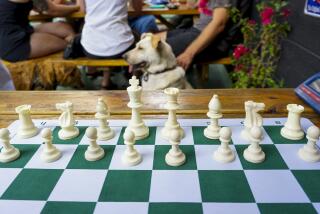Chess: Ruslan Ponomariov wins in Dortmund
Position No. 6118: White to play and win. From the game Tatev Abrahamyan-Sabina Foisor, U.S. Women’s Championship, St. Louis 2010.
Solution to Position No. 6117: White wins with 1 Nce4! dxe4 2 Nxe4 Rg6 3 Rd1 Qh4 4 Rxc6! bxc6 5 Nf6+. Or, if 2…Qg6, then 3 Nf6+ Kf8 4 Qd6+ Kg7 5 Nxg8 Kxg8 6 Rg3 gains plenty of material.
Ukraine grandmaster Ruslan Ponomariov won the Sparkassen double round robin in Dortmund, Germany. He scored 61/2-31/2, finishing a point ahead of Vietnamese sensation Le Quang Liem.
Ponomariov, ranked 14th in the world, is a solid defender best known for two feats as a teenager. In 1997, he became a grandmaster at age 14 years, 17 days, the youngest ever at that time. And in 2002, he won the World Chess Federation world championship in a controversial 128-player tournament that lacked the top stars. Although he is a consistently strong competitor who finished second in the World Cup in December, his Dortmund triumph still counts as a mild upset.
Ponomariov’s only loss came against 19-year old Le, who did not look a bit outclassed in his elite tournament debut. Le earned an invitation thanks to successive wins in two Moscow events in February.
Former world champion Vladimir Kramnik of Russia calls the annual Dortmund tournament his favorite, and he has won it nine times. He didn’t come close this year, needing a last-round victory to reach 5-5 and tie Shakhriyar Mamedyarov of Azerbaijan for third place. Peter Leko (Hungary) and Arkadij Naiditsch (Germany) tied for last place at 4-6.
Local news
The U.S. Open and a host of side events continue daily through Sunday at the Hyatt Regency, 17900 Jamboree Road in Irvine.
The Southern California Chess Federation’s round robin state championship begins Aug. 14. The SCCF offers chess lessons, books, and entry fees to those who donate money to the tournament. For more information, see scchess.org.
Dr. Joseph Wagner of Los Angeles created a slideshow, “The Beauty of Chess,” that has been displayed at the Chess Hall of Fame. You can see it at pvseniors.org/_videos.cfm.
The Pasadena Chess Club will begin the four-round Tim Pellant Memorial Friday in the Boys and Girls Club, 3230 E. Del Mar Blvd. in Pasadena. Register at the site before 6:50 p.m. Call Neil Hultgren at (818) 243-3809 for details.
The La Palma Chess Club has awarded the best game prize in its recent Igor Ivanov Memorial to Leigh Hunt for his victory over Robert Hutchinson.
Today’s games
GM Ruslan Ponomariov (Ukraine)-GM Vladimir Kramnik (Russia), Dortmund 2010: 1 d4 Nf6 2 c4 e6 3 g3 Inviting 3…d5, the Catalan Opening. Bb4+ 4 Bd2 Be7 5 Bg2 d5 6 Nf3 0-0 7 0-0 c6 8 Qc2 b6 A normal Catalan position, except for the “extra” move Bc1-d2. Often White chooses 9 Bf4 to clear d2 for a Knight and to unblock the d-file. 9 Rd1 Ba6 10 Ne5 After 10 b3, Kramnik drew Anand with 10…Nbd7 11 Bf4 Rc8 12 Nc3 Qe8. Qc8 Not a novelty, but rare. Theory claims a small advantage for White after the usual 10…Nfd7 11 cxd5 cxd5 12 e4. 11 Nc3 Sharpest. White would get more than enough compensation from 11…dxc4?! 12 Ne4 b5 13 b3 cxb3 14 axb3. Nbd7 12 Rac1 Nxe5 13 dxe5 Nd7 14 cxd5 cxd5 Against 14…exd5, the computer suggests 15 b4!? Bc4 16 b5 to undermine d5. 15 Bf4 Black has few worries after 15 f4 Qb7, but 15 Qa4!? Qb7 16 Be3, intending 17 Nxd5, looks promising for White. g5! Black must rely on tactics to fend off his better-developed opponent. The overly patient tries 15…Qb8? 16 Nxd5 exd5 17 e6 and 15…Qe8?! 16 e4 are inadequate. 16 Bxd5! exd5 Not 16…gxf4?, as 17 Bxa8 costs Black the exchange. 17 Nxd5 Qd8 More natural and probably stronger than the computer’s preference of 17…Bd8 18 Qd2 Qb8! (not 18…Qb7? 19 Bxg5) 19 e6 gxf4 20 e7 Qe5! 21 exf8Q+ Nxf8. 18 Nc7 Rc8?? But this error lets White pile up on the pinned Knight. Instead, 18…gxf4 19 Qf5 Bc8 20 Nxa8 fxg3 21 hxg3 Nc5 22 Rxd8 Bxf5 23 Rxf8+ Kxf8 reaches a defensible endgame. Or, if 18…gxf4 19 Nxa6, Black counterattacks with 19…fxg3 20 hxg3 Bg5 21 f4 Bxf4! 22 gxf4 Qh4 23 Qf5 Kh8, planning 24…Rg8+. 19 e6 fxe6 Also hopeless is 19…gxf4 20 Rxd7 Rxc7 21 Qxc7 Qxc7 22 Rcxc7. For example, 22…Bf6 23 e7 Re8 loses a Bishop to 24 Rxa7 Bb5 25 Rd8. 20 Qc6! Qe8 21 Qxe6+ Qf7 22 Qxf7+ Kxf7 23 Nxa6 gxf4 Also 23…Rxc1 24 Bxc1 leaves Black two pawns down. 24 Rxc8 Rxc8 25 Rxd7 Rc2 The tricky 25…Ke6 26 Rxa7 Rc2 doesn’t help, as 27 Nc7+ Kf5 28 Nd5 Bd6 29 Kf1! Rxb2 30 Nxf4 simplifies. 26 Nb4! Rxb2 27 Nc6 Rxe2 If 27…Ke6 28 Rxe7+ Kd6, White harvests pawns by 29 Rxh7 Kxc6 30 Rxa7 Rxe2 31 Kg2. 28 Rxa7 f3 29 h4 h5 30 Rxe7+ Rxe7 31 Nxe7 Kxe7 32 g4! hxg4 33 Kh2 Ke6 34 Kg3 Kf5 35 a4 Ke4 36 Kxg4, Black Resigns.
IM Irina Krush-Katarina Rohonyan, U.S. Women’s Championship, St. Louis 2010: 1 d4 d5 2 c4 c6 3 Nf3 Nf6 4 Nc3 a6 A popular relative of the Semi-Slav 4…e6, but Black does not shut in her light-square Bishop. 5 c5 Nbd7 6 Bf4 Nh5 Routine development, by 6…g6 7 e3 Bg7 8 h3, would grant White permanent control of the b8-h2 diagonal. 7 Bd2 Nhf6 Morozevich experimented with 7…e5!? 8 Nxe5 Nxe5 9 dxe5 Qe7. 8 Qc2 g6 Another idea is 8…e5!? 9 dxe5 Ng4. 9 h3 Qc7 Else 10 Bf4. 10 e4 Nxe4 11 Nxe4 dxe4 12 Ng5 The first new move. Several games have tested 12 Qxe4 Nf6 13 Qe5 Qxe5 14 dxe5, when 14…Ne4 15 Be3 Be6 16 Bd3 Bd5 should equalize. h6 13 Nxe4 Bg7 14 Bc4 Nf6 Cautious. Obviously 14…Bxd4? 15 Bxf7+! Kxf7 16 Qc4+ favors White, but Black can try to preface the pawn grab with 14…f5!? 15 Ng3 Bxd4 or 14…b5!? 15 cxb6 Nxb6. Either line appears more promising than the game. 15 Nxf6+ Bxf6 16 Qb3! e6 17 Be3 White has won the first skirmish. However, Black can dream of …e6-e5, freeing her Bishop. Bd7 18 Qc2 Bg7?! This hesitation lets White establish a bind. Black’s disadvantage is tolerable after 18…e5! 19 0-0-0 0-0-0 20 d5 cxd5 21 Bxd5 Bc6. 19 0-0 0-0 20 Qd2 Kh7 Worse is 20…g5? 21 f4. 21 Bf4 Qd8 22 Bd6 What a Bishop! It shields the d-pawn while denying Black the use of b8. Re8 23 Rfe1 a5 24 Re3 b6 Hoping for …Bd7-c8-a6. A trade of light-square Bishops would ease Black’s defensive task. 25 Rae1 bxc5 If 25…Bc8, then 26 Rf3! continues the pressure, as 26…f5 27 Rfe3 would cost Black the e-pawn. 26 dxc5 Bc8 27 Qe2 a4 28 Qf3 Qd7 29 b4!? axb3 30 Bxb3 Ba6 This Bishop is still no match for White’s, which can cause trouble from b3 or c2. 31 h4! When the opponent lacks counterplay, one must attack! h5 After 31…Kh8 32 h5 g5, White opens lines with 33 Qe4 and 34 f4. 32 g4 Now 32…hxg4 33 Qxg4 Bh6 34 Rg3 positions White for a breakthrough. For example, 34…Rg8 35 Qe4 Bc8 36 h5 f5 runs into 37 Qh1 Qe8 (trying to protect g6 and c6) 38 hxg6+ Rxg6 39 Ree3 Ra7 40 Be5, and White wins. Bh6 33 gxh5! A small investment clinches victory. Bxe3 34 hxg6+ fxg6 35 Rxe3 All of Black’s pawns are vulnerable and her King is exposed. There is no defense. e5 Against 35…Qg7, the flashy 36 h5! gxh5+ 37 Kh1 wins quickly. 36 Bc2 Re6 37 h5 Rxd6 Or 37…Rg8 38 Qh3. 38 cxd6 Kg7 39 Rxe5 Qxd6 40 Rg5 Rf8 41 Qc3+ Rf6 42 Rxg6+ Kf7 43 Qxf6+ Good enough, but 43 Bb3+ Ke7 44 Rg7+ Ke8 (or 44…Kd8 45 Qa5+) 45 Qe3+ Kd8 46 Qb6+ ends it sooner. Qxf6 44 Rxf6+ Kxf6 45 h6 c5 46 Kg2 Bc4 47 a4 Ba2 48 Kf3 c4 49 Ke3, Black Resigns. White handles 49…Bb3 effortlessly by 50 Bxb3 cxb3 51 Kd3.

